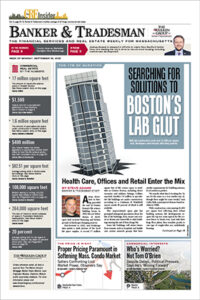
New York City’s largest recent office-to-residential conversion will create more than 1,500 housing units. Image courtesy of Gensler
Boston is at a critical juncture as it faces a growing housing shortage alongside an abundance of underutilized office space. While the city has a strong history of bold urban development, it has been slower than others in adopting office-to-residential conversions as a solution.
Of particular note is New York, which has emerged as a leader in this effort. Gensler recently completed New York City’s largest office-to-residential conversion to date, Pearl House, and is now embarking on an even larger project that will deliver over 1,500 housing units.
There are a few key reasons why New York City is experiencing faster conversion momentum than Boston, starting with the scale of the available office inventory here.
New York simply has a much larger volume of buildings to work with. The city’s five boroughs comprise nearly 730 million square feet of office space, with the vast majority – 82 percent, or about 600 million square feet – located in Manhattan. This gives developers a broader range of potential properties to evaluate for conversion. In contrast, Boston’s 70 million square feet of office space limits the pool of candidates, and there are fewer buildings to choose from.
Building Shapes and Zoning Flexibility
New York’s more regular street grid and building footprints make office-to-residential conversions easier to execute. Manhattan’s rectangular blocks are more conducive to laying out residential units efficiently, allowing for adequate access to daylight and fresh air. Boston’s historic neighborhoods, while charming, often feature irregularly shaped buildings and blocks that pose significant challenges when trying to reconfigure floor plans for residential use.
New York also had a head start offering incentives since prior to the COVID-19 pandemic. City policymakers have also loosened zoning restrictions for residential conversions. And New York’s housing market supports a higher tolerance for unconventional layouts and unique units, which can make conversions more feasible, reducing uncertainty for developers.
New York City also has an ally in New York State, in the form of property tax abatement for between 25 and 35 years for conversions. This policy helps offset the high costs associated with conversions and makes it easier for projects to be financially viable. For developers, this reduces long-term costs factored into underwriting. In June, Massachusetts Gov. Maura Healey announced a statewide pool of $15 million that gives developers $215,000 for each income-restricted unit in office buildings converted into housing.
Building Valuations and Managing Risk
In some parts of New York, the value of office buildings has declined significantly, making conversions more economically attractive than keeping them as office space. Lower acquisition costs give developers the breathing room needed to make the financials work. In Boston, however, we are still encountering inflated expectations around building valuations and their future viability to attract office tenants.
Ultimately, the biggest factor of all is clarity of risk in the process, expectations and cost. Developers won’t commit to converting an office building if they can’t clearly see how the project will pencil out financially.
One of the biggest challenges in Boston is the fear factor associated with being the first to undertake a large-scale office-to-residential conversion. Most of Boston’s current conversions are relatively small in scale. In contrast, New York has already seen substantial conversions. Developers in New York have had the benefit of seeing these large-scale conversions succeed, which reduces perceived risk for future projects.

Jared Krieger
Waiting for the First Domino to Fall
So, when will the first large-scale conversion project in Boston finally take off? The pieces are starting to come together. Several quality office buildings with low leasing potential are either on the market or will be soon, and Gensler’s proprietary algorithm has identified numerous properties in Boston that show strong potential for conversion. As office building values continue to decline, the economic conditions may soon align to make conversions more feasible.
In the meantime, Boston’s leadership is working hard to support these initiatives. Mayor Michelle Wu’s administration has extended the city’s office-to-residential conversion program – with added funding from the state – through December 2025, signaling a strong commitment to making this path more feasible. They continue to demonstrate a willingness to work collaboratively and have evolved their process since the initial pilot launch, including by now permitting compact living units.
With the right combination of political will, policy incentives and developer confidence, Boston is inching closer to realizing its own wave of office-to-residential conversions. As New York has shown, success is possible with the right strategies in place. Now, it’s up to Boston to turn the corner and capitalize on the opportunities ahead.
Jared Krieger is co-managing director of Gensler’s Boston office.






